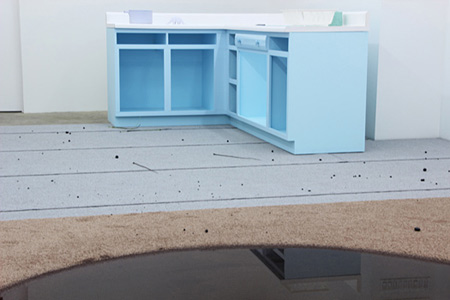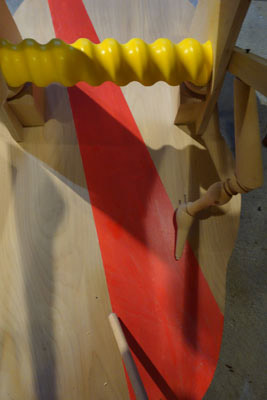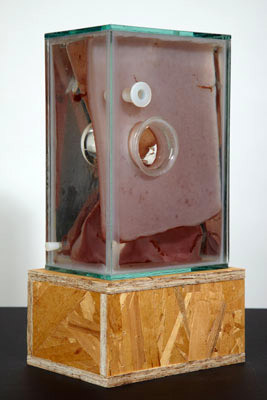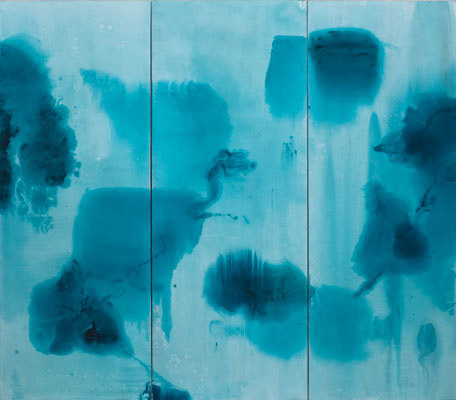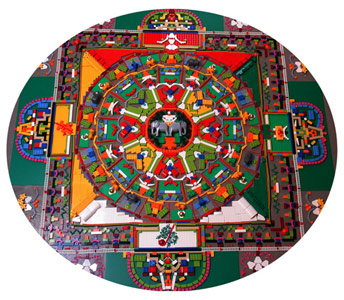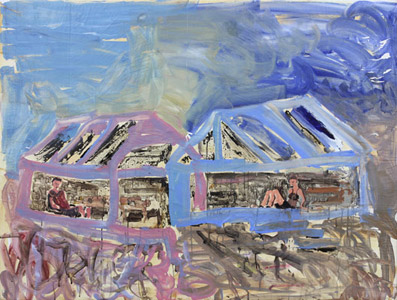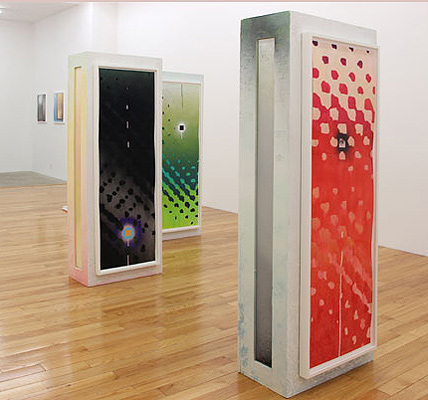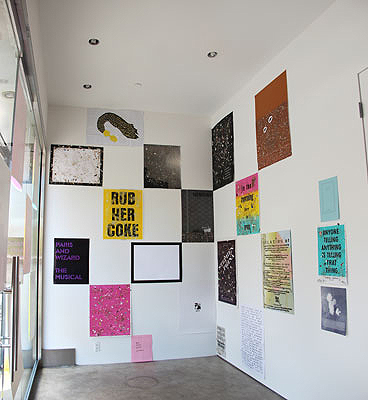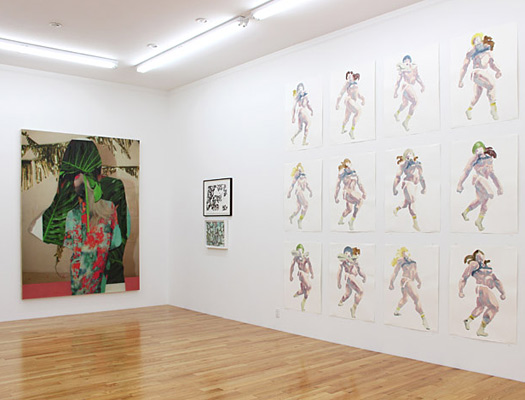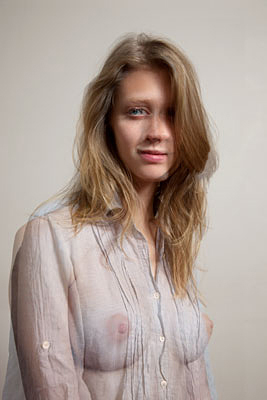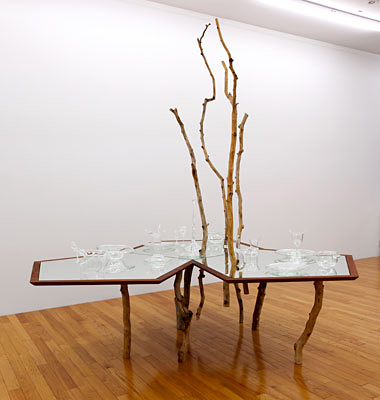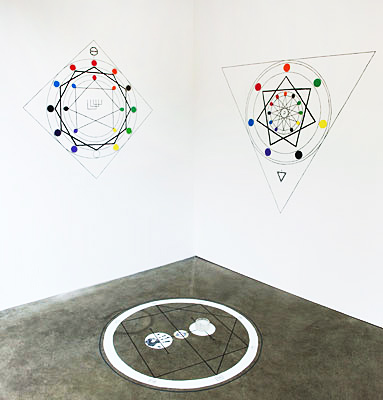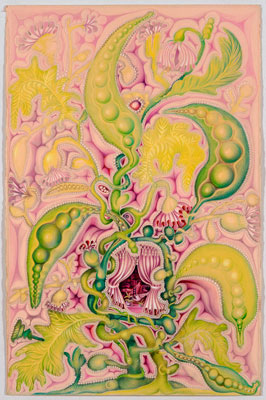RICHARD BLOES’s objects generally appear as loosely assembled elements from store-bought self- assembly kits, woodshop scraps, and found performance props that are anachronistically punctuated with the hard edge and movement of a video. In actuality the objects are highly organized sequences of things and stuff that are manipulated by friends and family according to a script by the artist, who documents the action in real time on video. |
|
| Reading Chair For Don Quixote Reading, 2012 (detail) |
For many years, JENNIFER SIREY has been cultivating bacteria to produce some of the elements of her sculpture. Her most recent water-filled glass tanks are penetrated by bulbous hand-blown glass tubes and as well, irregularly divided up by angled sheets of bacterial growth. On one level the sculpture is a highly aestheticized formal abstraction and on another it is a gnarly investigation into the body. In these particular works, to create the angled sheets, Sirey fills the tank to a predetermined level with a mixture of her mother culture and wine or sake, then tilts the tank so that the surface of the liquid aligns to the armature of small monofilament loops attached to the glass. After a few days, the bacteria Acetobacter (the same bacteria used to convert wine into vinegar) begin to attach to the armature and soon form a skin on the liquid’s surface. Once the membrane reaches the desired thickness, the tank is carefully drained and replaced with water mixed and white vinegar to stabilize the environment. The final piece is alive but in a state of hibernation. |
|
| Mollusc, 2011 |
Upfront hosts a BOBBIE OLIVER painting, Summer Triptych 1 (2012), which veils and reveals the mutability of its development and redevelopment. |
|
| Summer Triptych I, 2012 |
DAVID DEUTSCH: Neighbors and Strangers While these recent paintings by David Deutsch appear extremely different from those of the last 25 years, continuity can be seen in their combining of abstraction and representation, the perspective of surveillance or observation, and sense of the impending. With regard to his occasional but notable rotunda paintings, 16 or so painted between 1989 and 2003, the connection is most simply the figure within a container. These recent paintings are transfers and as such are related to the painting process for David’s plywood paintings from the early 70s. They are painted in acrylic on plastic sheeting, allowed to dry, an appropriately sized canvas is primed with a medium, and the plastic sheeting is placed paint surface down onto the primed canvas, smoothed and let to set for a day or two and then peeled away. The painted image has been absorbed into the medium covered surface of the canvas and the pulled plastic is again clear. This reversal is a distancing process, a device similar to checking out the strength of a painting’s form by looking at it upside down or in a mirror, and as well allows a myriad of seams, creases, ridges, and distressed surfaces that occur during the printing process to undermine the expressionist brush work of the so called painting. These qualities lure us into inspecting the paint application and separate us from the subject matter. Yet once we enter the physical uncertainty of the materiality we find that this alternate universe is indeed embedded in the other. The new in these David Deutsch paintings is based in the loose expressiveness of the hand creating the passages of paint that build the muddy emotional weather and flimsy structures in which the colorful |
||
| Sunset, 2013 | ||
|
David Deutsch was born in Los Angeles in 1943 and attended the University of California, Los Angeles, and the California Institute of the Arts, Los Angeles. I’ve been a fan of his paintings since his mid 80s exhibitions at BlumHelman Gallery and am delighted to host his first solo show at Feature Inc. |
||
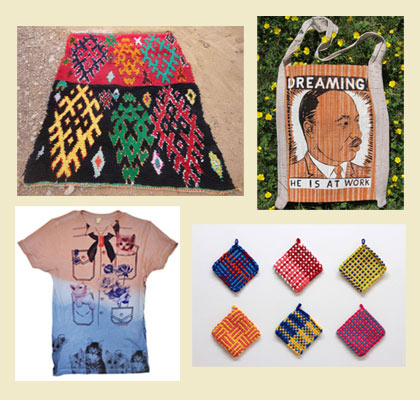 |
Gallery:
|
|
| clockwise from top left:Magic Flying Carpets of the Berber Kingdom, Jhola Bags by 5 Year Plan, Potholders by Mary Clarke , T–Shirts by Deli Grocery Specialty Products |
Upfront: Evie Falci Evie Falci dazzles the upfront downtown style with her rhinestones on denim. She was born in Brooklyn, attended Maryland college of art, and currently lives in Brooklyn |
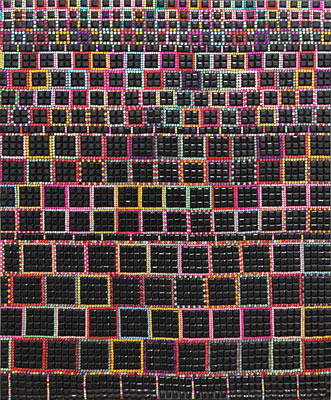 |
|
| Wall, 2013 | ||
